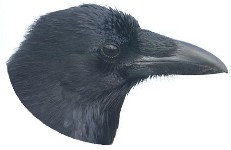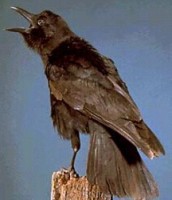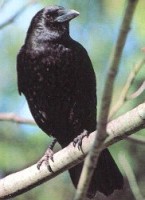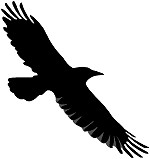  Crows are thought to be the most intelligent of all birds. A crow is a large black bird that lives everywhere the world except Antarctica, New Zealand, and South America. Crows belong to a family of birds which also includes jays, ravens and magpies ... the family Corvidae. The common crow (also called the American crow, Corvus brachyrhynchos) lives in open areas, farmland, the edges of woods, and parks throughout North America. Crows usually stay in the same region the year around ... only those living in the far north migrate south for the winter.  The American crow is about 43 to 53 centimeters long. It has black shiny feathers and a strong, sharply pointed bill. Male and female American crows look alike, but the female is slightly smaller. The female lays four to six greenish-blue eggs with brown spots; these are incubated for about 18 days. Both the male and female care for the young, which are called simps; they leave the nest after about a month. Adult crows live for about 10-12 years. Owls and hawks are two of the main predators of crows. Crows in flocks will often attack an intruding hawk or owl in an attempt to drive it from their territory. Humans are also responsible for killing many crows.  Crows do not have good singing voices, but they do use more than 23 calls to communicate with one another, and can mimic noises made by other birds and animals. Crows build nests from small sticks high in a tree, (where the term for the top of a ship's mast, the 'crow's nest', originated), or sometimes on telephone poles. When not nesting, crows often gather in large groups to roost during the night. Crows are usually monogamous, with mated pairs staying together for many years. A group of crows is called a 'murder' of crows. Not only will crows defend their own family, but they will also attempt to protect other crows that are in danger. Crows do not have good singing voices, but they do use more than 23 calls to communicate with one another, and can mimic noises made by other birds and animals. Crows build nests from small sticks high in a tree, (where the term for the top of a ship's mast, the 'crow's nest', originated), or sometimes on telephone poles. When not nesting, crows often gather in large groups to roost during the night. Crows are usually monogamous, with mated pairs staying together for many years. A group of crows is called a 'murder' of crows. Not only will crows defend their own family, but they will also attempt to protect other crows that are in danger.  Crows are omnivorous (like humans) ... they eat just about anything. They will eat a farmer's crops, and are especially fond of corn. They also feed on many kinds of insects, spiders, small birds, eggs from other birds' nests, seeds, rodents, and the flesh of dead animals. They will also consume garbage. Often crows will hoard food, sometimes burying it. The crow is now understood to be a highly intelligent animal, capable of complex communication and problem-solving. Crows drop nuts on the street and wait for automobiles to crush them, then fly down to eat the pieces. They will use a short twig (that they have pruned and shaped in advance), held in their beak, to dig insects out of the bark of a tree. It was previously thought that only primates had this ability. There are many anecdotal records testifying to the intelligence of this bird:  - Tony Angell, a naturalist, describes a European crow that learned to pull fish out of the water after watching ice fishermen do the same thing; when the flag snapped up indicating a fish on the line, the bird would swoop in and drag the line out of the water with its beak and feet until the fish flopped out of the hole.
- Tony Angell, a naturalist, describes a European crow that learned to pull fish out of the water after watching ice fishermen do the same thing; when the flag snapped up indicating a fish on the line, the bird would swoop in and drag the line out of the water with its beak and feet until the fish flopped out of the hole.
- Nature writer Candace Cavage describes a crow that moistened dry food provided by humans, by filling a small plastic cup with water and dumping it over the food! - There are documented cases of crows assisting wounded members of their flock by distracting predators. - British zoologists were amazed when they saw a captive crow called Betty making a hook out of wire to reach food. This was the first time any animal has been observed creating a new tool for a specific task.  |